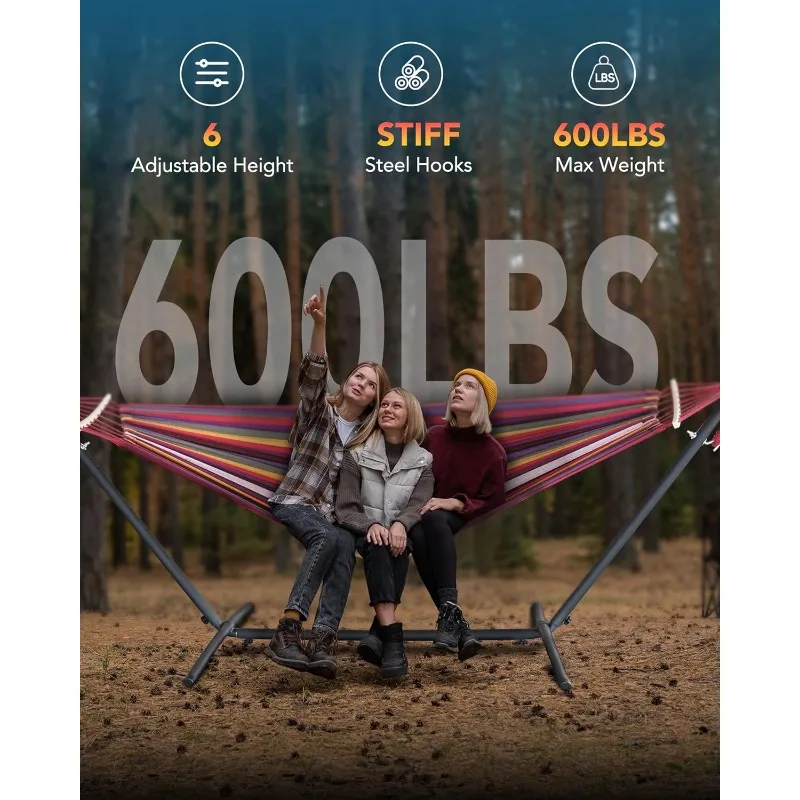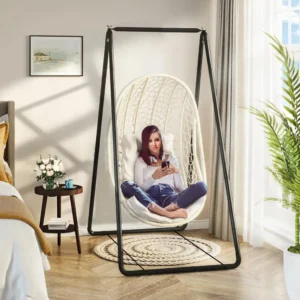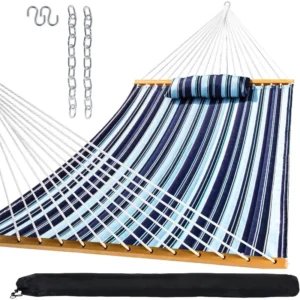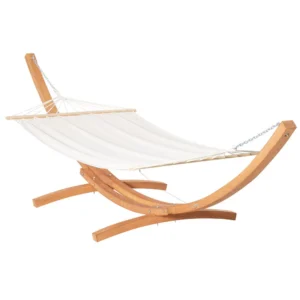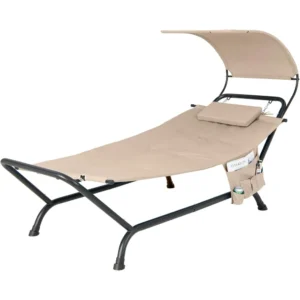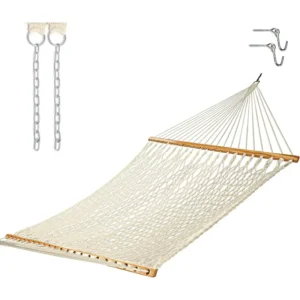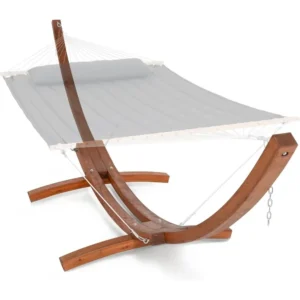Introduction to Fabric Hammock Durability
When it comes to outdoor relaxation, a hammock’s ability to withstand the elements makes all the difference between a lasting investment and a disappointing purchase. True durability goes beyond just strong fabric—it encompasses how materials resist breaking down under sunlight, repel water, and maintain their structure and appearance over time.
Selecting the right hammock material is perhaps the most crucial decision affecting longevity. Different fabrics respond dramatically differently when faced with:
- Intense UV radiation that breaks down fibers and fades colors
- Persistent moisture that encourages mold and mildew growth
- Temperature fluctuations that stress fabric integrity
- Environmental contaminants like tree sap, bird droppings, or pollen
Without proper material selection and care, environmental factors can reduce a hammock’s usable lifespan by up to 70%. However, with the right choices, your outdoor hammock can provide years—even decades—of comfortable relaxation.
This guide will walk you through exactly what happens to different hammock materials in outdoor conditions and how to choose options that will truly stand the test of time. Proper indoor and outdoor hammock placement also plays a significant role in extending your hammock’s life.
Why Fabric Durability Matters: The Impact of Sun and Rain
The Damaging Effects of UV Radiation
Sunlight might feel wonderful while you’re lounging, but it’s silently breaking down your hammock with every exposure hour. Ultraviolet radiation affects hammock fabrics in several critical ways:
- Color Fading: UV rays break chemical bonds in dye molecules, causing vibrant colors to appear washed out and dull
- Fiber Breakdown: Radiation damages the polymer chains that give fabric its strength, making material brittle and prone to tearing
- Tensile Strength Loss: Many natural fibers lose 30-60% of their original strength after just one season of regular sun exposure
Moisture: The Silent Destroyer
Rain, morning dew, and humidity pose equally serious threats to hammock longevity:
- Mold and Mildew: Damp fabric creates perfect conditions for biological growth that weakens fibers and creates permanent staining
- Rot in Natural Fibers: Cotton and other natural materials can literally decompose when consistently moist
- Structural Weakness: Some fabrics can lose up to 20% of their tear resistance when wet
- Weight Stress: Water absorption adds significant weight, putting extra strain on attachment points and stitching
Understanding these environmental challenges helps explain why certain materials perform dramatically better outdoors than others. The question of whether it’s okay to leave a hammock outside depends greatly on what it’s made from.
Comprehensive Comparison of Hammock Fabrics
To help you make the best choice for your environment, we’ve evaluated the most common hammock materials based on several key factors: UV resistance, water repellency, drying speed, mold resistance, comfort, and expected lifespan. Each fabric receives ratings on a 1-5 scale (with 5 being excellent) based on laboratory testing and real-world performance data.
Remember that comfort and durability often involve tradeoffs—though modern materials are increasingly bridging this gap. Our comprehensive outdoor fabric hammocks guide provides additional context on these materials.
Cotton Hammocks
Traditional cotton hammocks offer unsurpassed comfort but come with significant durability challenges in outdoor settings:
- Comfort: 5/5 – Soft, breathable, and adapts perfectly to body temperature
- UV Resistance: 1/5 – Begins breaking down within 3-4 weeks of regular sun exposure; loses approximately 50% strength within one season
- Water Resistance: 1/5 – Absorbs water readily, increasing weight by up to 30%
- Drying Speed: 1/5 – Takes 4-5 times longer to dry than synthetic alternatives (8+ hours in humid conditions)
- Mold Resistance: 1/5 – Extremely susceptible to mildew and mold growth within 24-48 hours in damp conditions
Ideal Use: Indoor settings, covered porches, or occasional outdoor use with diligent storage during damp periods. Perfect for users prioritizing traditional feel and comfort over weather resistance.
Polyester Hammocks
Polyester offers an excellent balance of durability, weather resistance, and value:
- Comfort: 3/5 – Less breathable than cotton but still comfortable with a slightly crisp feel
- UV Resistance: 4/5 – Retains approximately 85% of its strength even after a full season of sun exposure
- Water Resistance: 4/5 – Naturally repels water and dries quickly
- Drying Speed: 4/5 – Typically dry within 1-2 hours in decent weather
- Mold Resistance: 4/5 – Resistant to biological growth when properly cleaned
Ideal Use: All-purpose outdoor hammocks for regular use in varying weather conditions. Perfect for practical users seeking good durability without premium pricing. Our fabric hammock sets feature several polyester options known for their resilience.
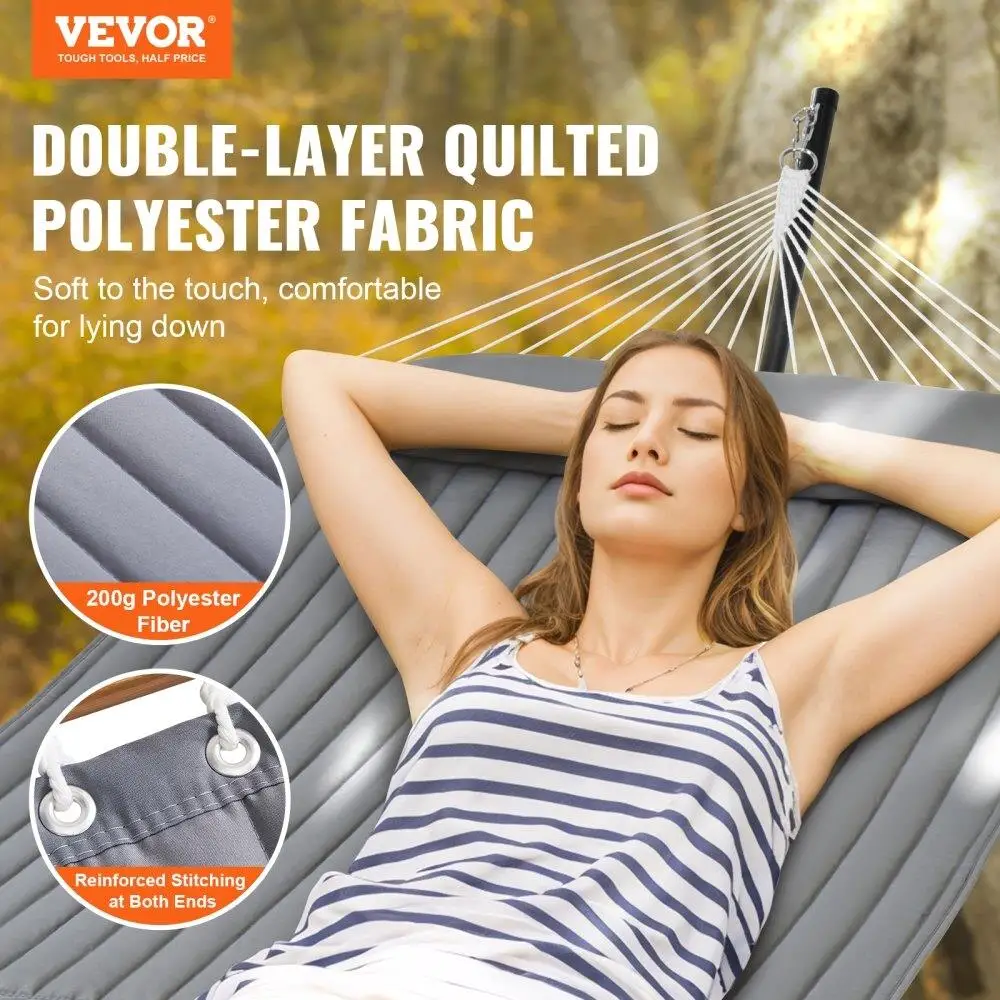
Nylon Hammocks
Nylon excels in portable applications where weight savings matter:
- Comfort: 3/5 – Silky feel but can be slippery and less breathable in hot weather
- UV Resistance: 3/5 – More vulnerable than polyester but still outlasts natural fibers
- Water Resistance: 5/5 – Superior water repellency
- Drying Speed: 5/5 – Fastest-drying common hammock material (often dry within 30-60 minutes)
- Mold Resistance: 5/5 – Excellent resistance to biological growth
Ideal Use: Travel, backpacking, camping, and situations where portability matters. Nylon’s exceptional strength-to-weight ratio makes it perfect for adventure hammocks that need to pack small and dry quickly.
Acrylic Hammocks (e.g., Sunbrella)
Premium acrylic fabrics represent the gold standard for permanent outdoor installations:
- Comfort: 4/5 – Closer to cotton’s feel than other synthetics, with superior breathability
- UV Resistance: 5/5 – Solution-dyed fibers resist fading for 5-7 years of continuous exposure
- Water Resistance: 5/5 – Advanced water-repellent treatments prevent absorption
- Drying Speed: 4/5 – Dries quickly when wet (typically 1-3 hours)
- Mold Resistance: 5/5 – Exceptional resistance to mildew, even in constantly humid environments
Ideal Use: Permanent outdoor installations, especially in harsh sun environments or coastal settings. The 3-5 year warranties commonly offered for Sunbrella and similar acrylic fabrics demonstrate manufacturer confidence in their durability.
Olefin (Polypropylene) Hammocks
Olefin combines excellent weather resistance with notable environmental benefits:
- Comfort: 3/5 – Softer than polyester but with less breathability
- UV Resistance: 4/5 – Naturally resistant to UV degradation without additives
- Water Resistance: 5/5 – Nearly hydrophobic with less than 1% moisture absorption rate
- Drying Speed: 5/5 – Dries extremely quickly due to minimal water absorption
- Mold Resistance: 5/5 – Superior resistance to biological growth
Ideal Use: Humid environments, pool areas, and settings where quick-drying capability matters most. Olefin’s recyclability also makes it a good choice for environmentally-conscious consumers seeking durable outdoor fabrics. Our comprehensive guide to choosing outdoor fabric hammocks provides more details about this material.
DuraCord and Specialty Blended Fabrics
Innovative hybrid materials offer the best of both natural comfort and synthetic durability:
- Comfort: 4/5 – Engineered to mimic cotton’s feel with synthetic performance
- UV Resistance: 5/5 – Advanced technologies prevent breakdown and color fading
- Water Resistance: 4/5 – Superior moisture management with cotton-like breathability
- Drying Speed: 4/5 – Quick-drying compared to natural fibers (typically 1-2 hours)
- Mold Resistance: 4/5 – High resistance to biological growth with proper care
Ideal Use: Premium installations where both comfort and durability are non-negotiable priorities. These materials bridge the gap between traditional comfort and modern performance for discerning users.
Ultimate Fabric Comparison Chart
| Material | UV Resistance (1-5) | Water Resistance (1-5) | Drying Speed | Comfort (1-5) | Average Outdoor Lifespan | Price Range | Best Use |
|---|---|---|---|---|---|---|---|
| Cotton | 1 | 1 | 6-8+ hours | 5 | 1-2 seasons* | $ | Indoor/covered areas |
| Polyester | 4 | 4 | 1-2 hours | 3 | 3-5 years | $$ | All-purpose outdoor |
| Nylon | 3 | 5 | 30-60 min | 3 | 2-4 years | $$ | Travel/portable use |
| Acrylic | 5 | 5 | 1-3 hours | 4 | 5-10 years | $$$$ | Permanent outdoor |
| Olefin | 4 | 5 | 30-60 min | 3 | 4-7 years | $$$ | Humid/wet environments |
| DuraCord/Blends | 5 | 4 | 1-2 hours | 4 | 5-8 years | $$$$ | Premium installations |
*With proper storage and care
For those seeking maximum durability, our quilted fabric hammock sets offer additional protective layers that extend lifespan significantly.
Key Factors Affecting Hammock Lifespan Beyond Material
While fabric selection is crucial, several other factors significantly impact how long your hammock will last outdoors:
Construction Quality
The finest materials still fail when poorly constructed:
- Stitching Integrity: Double or triple stitching at stress points can double a hammock’s useful life
- End Attachments: Reinforced attachment points prevent the most common failure mode
- Hardware Quality: Rust-resistant components prevent structural compromise and fabric staining
Usage Patterns
How you use your hammock directly affects its longevity:
- Weight Distribution: Consistently exceeding weight capacity can reduce lifespan by 40-60%
- Entry Technique: Proper getting in/out methods prevent unnecessary stress on fabric and attachments
Installation Considerations
Proper setup dramatically extends hammock life:
- Tension Management: Correct tension prevents both sagging damage and overstretching
- Angle Optimization: Hanging at 30-degree angles distributes weight properly
- Attachment Points: Using tree straps or proper hardware prevents concentrated stress
Climate-Specific Challenges
Your local environment creates unique durability challenges:
- Temperature Cycling: Repeated freezing and thawing weakens fibers
- Humidity Variations: Seasonal humidity changes stress materials
- Salt Exposure: Coastal environments accelerate hardware corrosion and fabric breakdown
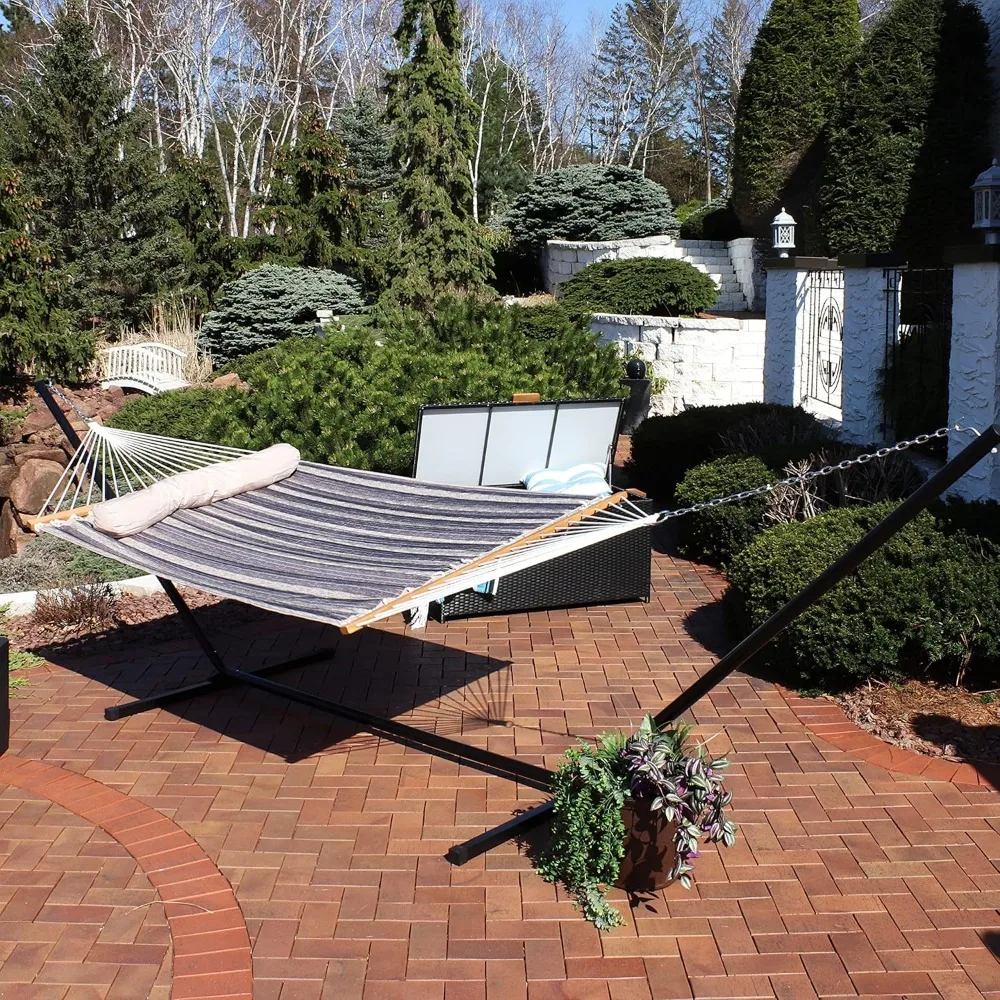
Maximizing Your Hammock’s Durability: Care and Maintenance Guide
Cleaning Protocols by Fabric Type
Regular cleaning significantly extends hammock life:
Cotton Hammocks:
– Hand wash with mild soap and lukewarm water
– Never use bleach or harsh detergents
– Air dry completely before storage or reuse
– Treat stains immediately with diluted white vinegar
Synthetic Hammocks (Polyester, Nylon, Olefin):
– Rinse with garden hose for light cleaning
– Use mild soap for stubborn dirt
– For tree sap: freeze with ice cube then gently scrape
– For sunscreen: dish soap works better than laundry detergent
Premium Materials (Acrylic, DuraCord):
– Spot clean with manufacturer-approved cleaners
– Use soft brushes rather than abrasives
– For bird droppings: remove solids first, then clean with enzymatic cleaner
Storage Recommendations
Proper storage prevents unnecessary damage:
- Store completely dry to prevent mold growth (critical for all materials)
- Keep in breathable storage bags, never plastic
- Store in climate-controlled environments when possible
- Fold rather than bunch to prevent permanent creases
Inspection Routines
Regular checks catch problems before they become critical:
- Examine stitching monthly for UV damage or fraying
- Check hardware for corrosion or bending
- Look for early signs of fiber breakdown (pilling, thinning)
- Test weight capacity gradually before full use after storage
Understanding how strong materials for hammock stands complement fabric durability ensures a complete approach to hammock longevity.
Protective Accessories to Enhance Durability
The right accessories can dramatically extend your hammock’s useful life:
Hammock Covers
A quality cover provides substantial protection:
- Look for covers made from UV-resistant materials themselves
- Choose designs with proper ventilation to prevent condensation
- Use during periods of non-use, especially for extended absences
- Consider weather-specific covers for different seasons
UV-Protective Treatments
Supplemental protection varies by fabric type:
- Cotton benefits most from UV protectant sprays (reapply every 3-4 weeks)
- Synthetic fabrics gain minimal benefit from aftermarket treatments
- Water-repellent sprays restore factory DWR treatments after washing
- Test any treatment on an inconspicuous area first
Strategic Placement Considerations
Where you hang your hammock matters as much as what it’s made of:
- Position hammock to receive morning rather than afternoon sun when possible
- Utilize natural shade patterns from trees or structures
- Consider seasonal sun angles when creating permanent installations
- Minimize exposure to tree sap, bird perches, and other contamination sources
Our heavy-duty hammock sets include models specifically engineered with additional protective features for challenging environments.
A-Frame Stand Hammock Sets, Swinging Hammock Chair Sets
$154.62 Select options This product has multiple variants. The options may be chosen on the product pageClassic Wooden Stand Hammock Sets, Heavy Duty Hammock Sets
$1,061.68 Select options This product has multiple variants. The options may be chosen on the product pageHammock Sets with Canopy, Heavy Duty Hammock Sets
$286.31 Select options This product has multiple variants. The options may be chosen on the product pageDouble / Two Person Hammock Sets, Rope Hammock Sets
Double Traditional Cotton Rope Hammock with Extension Chains – 450 lbs Capacity for Backyard & Patio$292.98 Select options This product has multiple variants. The options may be chosen on the product pageHeavy Duty Hammock Sets, Wooden Arc Stand Hammock Sets
$878.66 Select options This product has multiple variants. The options may be chosen on the product page
Realistic Lifespan Expectations for Outdoor Hammocks
Understanding realistic lifespans helps set appropriate expectations for your investment:
Cotton (Constant Exposure): 6-12 months before significant degradation
Cotton (With Care): 2-3 years with storage during inclement weather and winter
Polyester (Constant Exposure): 2-3 years before noticeable fading and strength loss
Polyester (With Care): 4-6 years with basic maintenance and seasonal protection
Nylon (Constant Exposure): 1-2 years before UV damage affects integrity
Nylon (With Care): 3-5 years with storage when not in use
Acrylic/Sunbrella (Constant Exposure): 5-7 years maintaining appearance and strength
Acrylic/Sunbrella (With Care): 8-10+ years with basic maintenance
Olefin (Constant Exposure): 3-5 years with minimal degradation
Olefin (With Care): 6-8+ years with basic maintenance
DuraCord/Blends (Constant Exposure): 4-6 years of maintained appearance
DuraCord/Blends (With Care): 7-10+ years with proper maintenance
When calculating value, consider cost-per-year rather than just initial price. Premium materials often deliver better long-term value despite higher upfront costs.
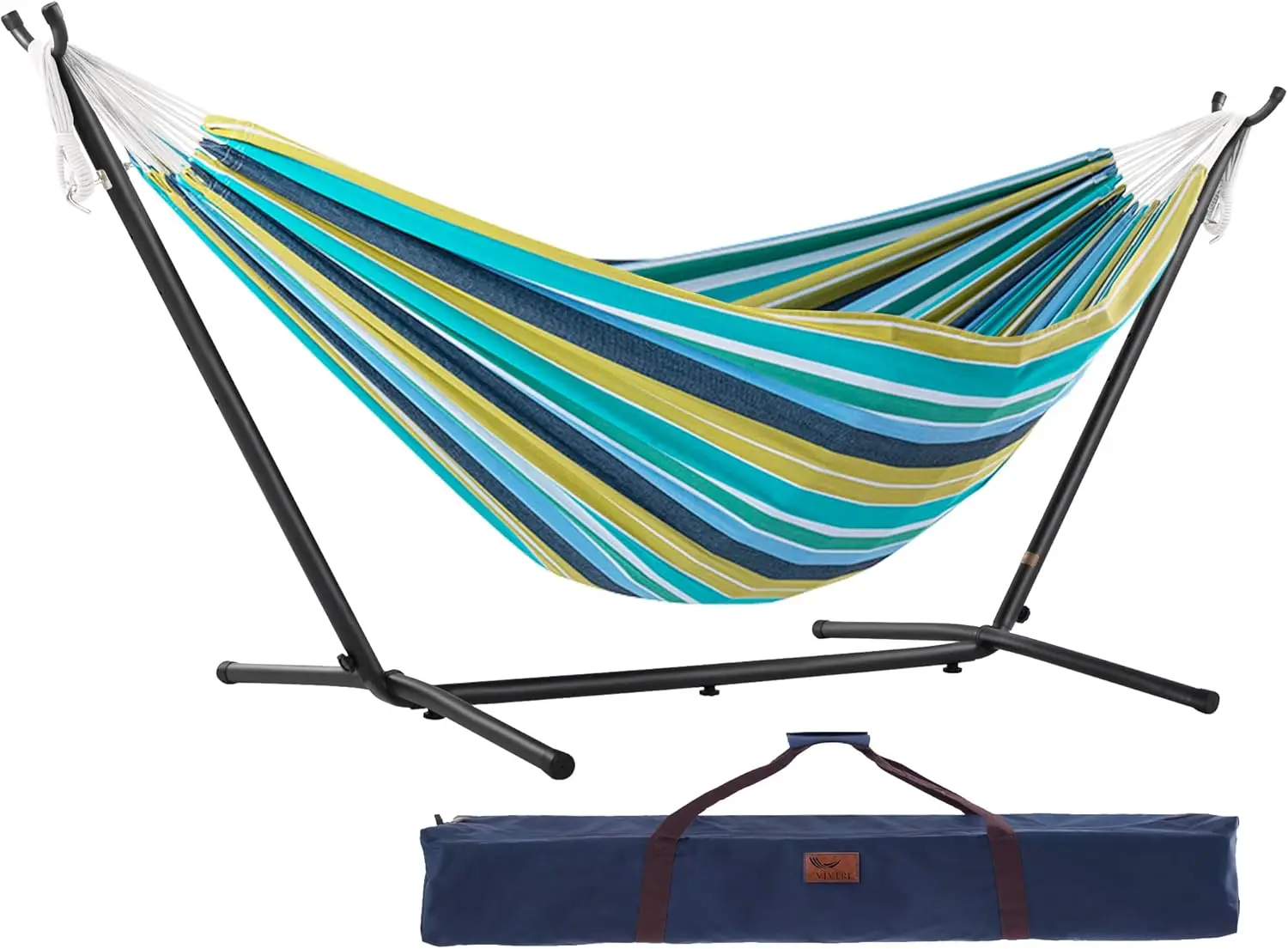
Making the Right Choice for Your Needs
Finding the perfect balance of durability, comfort, and price depends on your specific circumstances:
For Permanent Outdoor Installation (Full Sun Environment)
If your hammock will remain outside year-round in direct sunlight, invest in premium materials:
– Acrylic/Sunbrella fabrics provide the best long-term value
– DuraCord blends offer excellent balance of comfort and longevity
– Consider quilted construction for additional structural integrity
For Seasonal Use with Storage
If you’ll use your hammock during warm months but store it in winter:
– High-quality polyester provides excellent value
– Olefin works particularly well in humid climates
– Focus on proper storage techniques during off-season
For Occasional/Weekend Use
If your hammock will see intermittent use:
– Quality polyester offers the best balance of price and performance
– Focus on quick-drying capabilities for convenience
– Choose systems with simple storage options
For Humid/Coastal Environments
If you live in areas with high humidity or salt exposure:
– Olefin and acrylic resist mold growth best
– Look for corrosion-resistant hardware (stainless steel or powder-coated)
– Consider darker colors that show less mildew staining
Our quilted fabric hammock sets include options engineered for various environmental challenges.
Frequently Asked Questions About Hammock Durability
Can I leave my hammock outside year-round?
With acrylic, DuraCord, or high-quality olefin fabrics, year-round installation is possible. However, even these durable materials benefit from covers during extreme weather or extended periods of non-use.
How do I prevent mold and mildew on my hammock?
The key is keeping the hammock dry. Allow it to dry completely after rain or morning dew before folding or covering. For hammocks already showing mildew, clean with a solution of one part white vinegar to four parts water, rinse thoroughly, and dry completely.
What’s the best fabric for a hammock that will be in direct sunlight most of the day?
Acrylic fabrics like Sunbrella offer the best UV resistance, often maintaining color and strength for 5+ years even with constant exposure. DuraCord blends provide a close second.
How do I clean bird droppings from my hammock without damaging the fabric?
Remove any solid material first, then spot clean with a mild enzymatic cleaner. Avoid harsh scrubbing that might damage fibers. Rinse thoroughly and allow to dry completely.
Do hammocks lose their weight capacity over time?
Yes, especially when exposed to environmental factors. UV exposure can reduce a hammock’s weight capacity by 20-30% over time. Always maintain a safety margin below the rated capacity, especially with older hammocks.
Can I repair a hammock that’s starting to fade or fray?
Minor fraying can sometimes be repaired with matching thread and careful stitching. Fading is generally permanent, though some cotton hammocks can be re-dyed. Prevention is more effective than repair for most weather-related damage.
For complete relaxation solutions that withstand the elements, explore our collection of hammocks with stands designed for durability in various environments.

